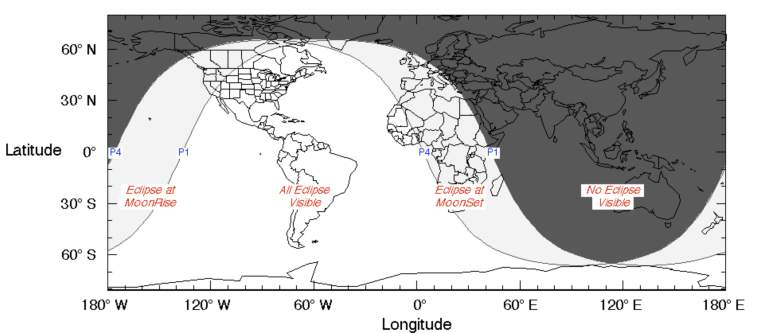
Alunar eclipse is happening the evening of July 4 into the early morning hours of July 5. This one will be visible in the United States, unlike last month’s solar eclipse. Read on to learn where you can see a map of the eclipse’s path and what time you should start watching for it if you plan to watch online.
Here Is the Lunar Eclipse’s Map & Path for Tonight
Tonight’s lunar eclipse is called a penumbral lunar eclipse. Earth’s shadow will fall on the moon, which only happens two to five times a year. This isn’t a total eclipse, but it’s a penumbral eclipse — which means it’s a more diffuse shadow. It’s more subtle.
NASA has provided a map of the July 4-5 lunar eclipse’s path here. You can see a screenshot of NASA’s map below. As you can see, it will be visible through most of the United States.
You can see another map of where the lunar eclipse will be visible at Time and Date here.
Note that although this eclipse is technically visible in the United States, you’re going to need a good pair of binoculars to see it. It’s not very dramatic and will be more of a slightly dimmed eclipse during the full “Buck Moon.”
What Time Can You Watch the Eclipse Online?
According to Time and Date, the penumbral eclipse will begin at 10:07 p.m. Central (11:07 p.m. Eastern) and it will be at its maximum size at 11:29 p.m. Central (12:29 a.m. Eastern.) The eclipse will end at 12:52 a.m. Central/1:52 a.m. Eastern.
Time and Date notes that in California, the maximum eclipse will be at 9:29 p.m. Pacific, starting at 8:07 p.m. Pacific and ending at 10:52 p.m. Pacific.
Remember, you’ll only be noticing that the moon is slightly darker. It won’t be completely blotted out and it won’t be turning red. If it’s cloudy, you might not be able to notice it at all. According to USA Today, the western part of the U.S. and Texas will have mostly clear skies for the eclipse. But New England and parts of the Central U.S. might face clouds.
The next penumbral eclipse is November 29-30, 2020 and it won’t be any more dramatic than tonight’s eclipse.
The next major total lunar eclipse in the U.S. is taking place on May 26, 2021. This will be visible in Australia, parts of the western U.S., western South America, or South-East Asia.
Another full lunar eclipse in the U.S. won’t happen until May 15-16, 2022. This will be visible from North and South America, Europe, Africa, and parts of Asia. This is a major lunar eclipse known as a Blood Moon.
The next total solar eclipse in the U.S. won’t happen until April 8, 2024. This one will have a line of totality crossing Texas, through the Midwest, and over Indianapolis, Cleveland, Buffalo NY, over New England, and passing over Maine and New Brunswick, Canada. This will also be the first total solar eclipse visible in Mexico since 1991.
Meanwhile, we won’t see the next coast-to-coast solar eclipse in the U.S. until August 12, 2045.
READ NEXT: Daily COVID-19 Updates
